Nelson Mandela death: How a Xhosa chief is buried
- Published
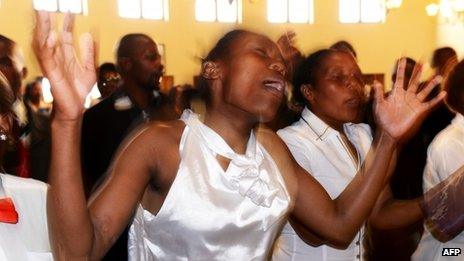
A memorial service took place on Friday in Mvezo, where Nelson Mandela was born, ahead of his burial in Qunu on Sunday
Nelson Mandela will be buried in his home village of Qunu on Sunday. As a chief from the Xhosa ethnic group, there will be lots of special rituals to observe, reports Xhosa cultural expert Somadoda Fikeni.
In Xhosa tradition, when somebody dies away from home, like Madiba, rituals of a symbolic return of the soul to the ancestral home are performed.
It is believed that one's soul needs to be at home and also be reunited at burial with the mortal remains for spiritual harmony to be attained.
Non-fulfilment of this procedure may lead to the spirit wandering restlessly and even causing misfortune to the family members as it expresses displeasure.
If this symbolic return is performed, it is thought that it will please the creator and the ancestors who mediate between the creator and the living, and therefore bring good fortune and much-needed protection to the family.
If any step in the process is missed, then a ceremony to correct that and appease the ancestors and the creator is performed.
As the mortal remains are being transported back home, a senior person or specialist is selected to perform all rituals necessary to invoke the return of spirit.
This, among other things, involves talking to the mortal remains, indicating that the return journey to the place of birth and the place where the umbilical cord was buried is commencing.
Special herbs and medicine are sometimes used in the process. The spirit is guided home by mentioning the names of the rivers and places being crossed.
This also involves invoking the izibongo (praise songs of the family or lineage group) and the mentioning of departed ancestors with whom the dead person is going to be united.
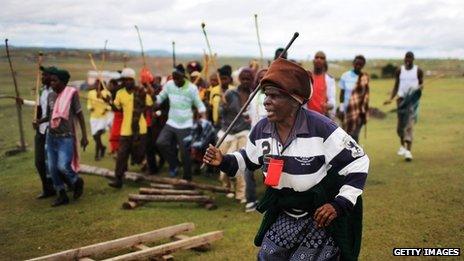
A Xhosa woman sings and dances as young men take part in a manhood ceremony in Qunu ahead of Nelson Mandela's funeral on Sunday
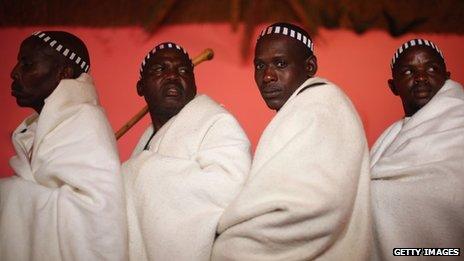
Xhosa men gather in an elder's home before slaughtering a cow as part of a a ceremony in Qunu, ahead of the funeral of Nelson Mandela.
On arrival, the spirit is also informed of the arrival and pleaded with to assist in mediating with the creator and reinforcing the ancestors in this work of protecting the family and the nation.
For the funeral itself, cattle are slaughtered by a designated person who uses a traditional spear of the home or clan.
If the cow, ox or bull that is slaughtered makes a bellowing sound during the slaughter, this is taken as a signal that ancestors are pleased and will welcome the departed person.
In some instances, another animal is slaughtered as a replacement for the one that did not bellow.
If the deceased is from a royal family or is a chief or king then these rituals are more elaborate.
For example, the coffin is generally covered with a leopard skin if the person was a chief - like Madiba - and a lion's skin if the person was a king.
Traditional leaders or royalty stand guard next to the coffin during the funeral proceedings.
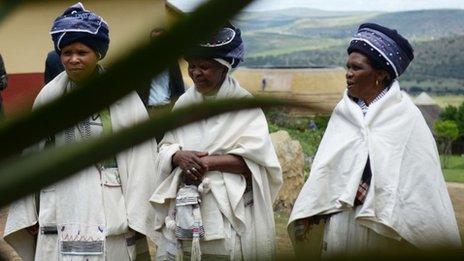
South African woman belonging to the Thembu clan arrive in Mvezo, to participate in a memorial service for Nelson Mandela

Rehearsals are under way for the funeral of Nelson Mandela in Qunu
At a given time a courtyard imbongi (traditional praise poet with deep knowledge of the history of the chief or king being buried) introduces the deceased by reciting their traditional names and describing their characteristics.
In a strict traditional setting, the body of the person, especially a traditional leader, is wrapped in an animal skin.
Cow skin is used - often from the animal which has been slaughtered for the occasion.
A person is buried with their special belongings and the things they liked and used during their lifetime. Spears, a shield and tobacco were some of the commonly included items. Some people are buried in a sitting position, others in a sleeping position.
Again some rituals involving libation are performed during burial and on the grave.
Rain during the days leading up to or on the day of the funeral is interpreted as a good sign that the heavens and the spiritual world are welcoming the dead.
The morning of the funeral, and the week afterwards, are a close family affair that includes the slaughtering of a sheep or goat and use of herbs to cleanse the family of the departed person and call for their protection.
This occasion is also used to make speeches by the elders and senior family members who empower others with words of comfort and wisdom while reminding them of their roles, old and new, that will be crucial for the survival and sustenance of the family.
It is also during this period that specific details of how the family will observe the mourning period are revealed.
Often, those in mourning would not go to any social events for the entire period.
Some Xhosa families wear black for the entire period and these clothes are symbolically burnt at the end of the mourning period.

A man places a memorial poster on a fence at the perimeter of Nelson Mandela's property in Qunu
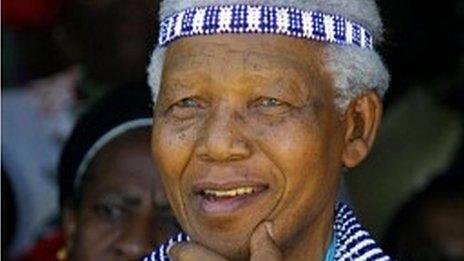
Nelson Mandela wore Xhosa dress on traditional occasions
In some families, widows in mourning do not cook for the entire period - someone else would have to do it for them.
After six months or a year, the mourning period ends with yet another elaborate ceremony where family and friends bring gifts to the widow(s) or children, symbolically to replace old items which might be closely associated with the deceased, for example a bed or blankets.
At this time, the emphasis is also on freedoms that the mourning person will again enjoy but with dignity and respect to honour the departed and family.
Long after the person has departed, family rituals and ceremonies will often involve invoking the dead person's spirit as an ancestor to mediate between the living and the creator. Such an honour is only reserved for people who had distinguished themselves and were virtuous during their life.
There is no doubt that Madiba will become such an ancestor, continuing to provide guidance to the family he has left behind.